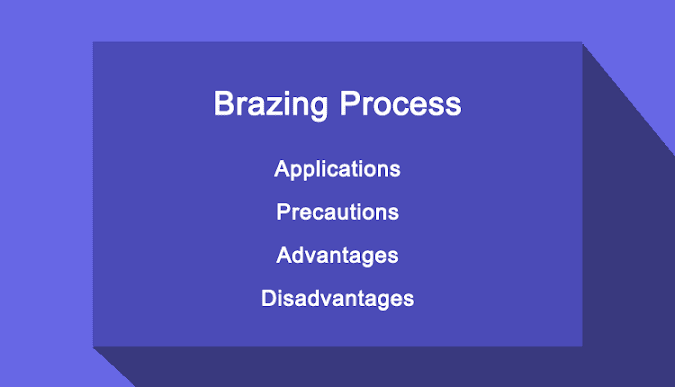Brazing - Applications, Precautions, Advantages and Disadvantages
Definition of brazing
Brazing is a metal-joining process in which the base metal is not melted, but joint obtained by melting of filler metal. The filler metal is brought slightly above its fusion temperature; molten filler metal is then spread into the joint by capillary action. Molten filler metal subsequently solidifies as it cool and join the workpieces together. The filler metals used for brazing are copper alloys.Application of brazing
Brazing is a widely used joining process because it can join almost all metal except aluminium and magnesium. It is used for electrical components, pipe fittings. Metals having uneven thickness can be joined by brazing.Precautions in brazing
Following points should be considered while brazing.- Clean the joints so that they do not contain any harmful elements.
- Avoid overheating, provide uniform temperature on the metal.
- Use appropriate filler metal and flux in the optimum amount.
- The joint should be tight.
- Provide an appropriate atmosphere.
Advantages of brazing
- Brazing is used to bond a variety of metals, dissimilar metals and even non-metals (e.g., metalized ceramics)
- Component tolerances maintained more accurately than welding. Brazing does not melt the base metal; it allows a much stricter control of the tolerances.
- They produced a clean joint; the completed joint requires little or no finishing. It is profitable because it does not require an expensive secondary operation.
- Corrosion resistance joints obtained by this method.
- Brazing preserves metallurgical characteristics of material because low temperatures.
- There is no arc or spark. The uniform heating of a welding part in the brazing process helps to minimize thermal distortion.
- Thin sheets and pipes that cannot be joined by welding can be joined by brazing.
- Provide excellent sealing as compared to spot welding, riveting and bolt fastening.
- Brazing processes can be easy to automate for bulk production.
Disadvantages of brazing
- The joints are not effective at higher temperatures. Because the low melting point of filler material.
- The color of the joint is often different from that of the base metal that create an aesthetic disadvantage.
- Weak joint as compared to welding.
- Metal to join must very close to ensure capillary action of molten filler metal.
- Need a flux during brazing and flux residue must be removed.
- The job size is limited - large plates of metal can't braze.
Difference between soldering and brazing
Advantages and disadvantages of welding joints


